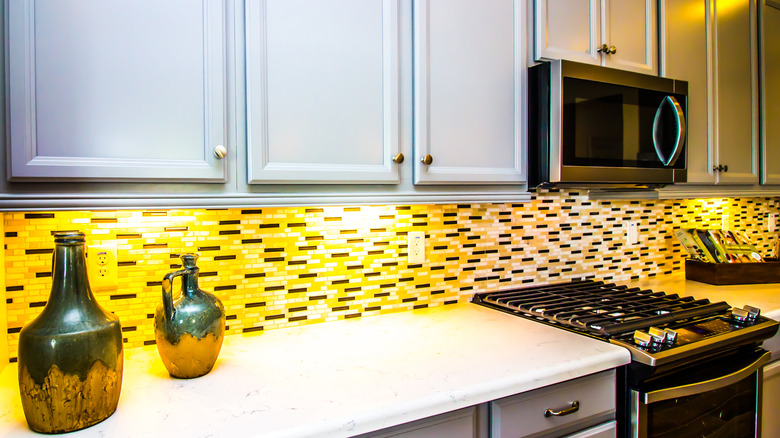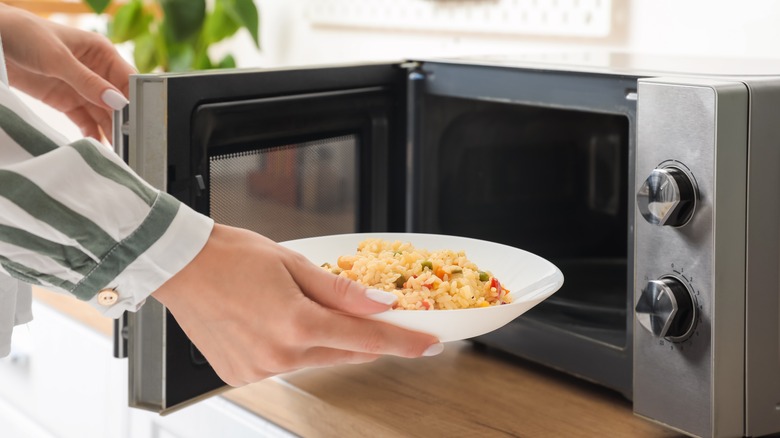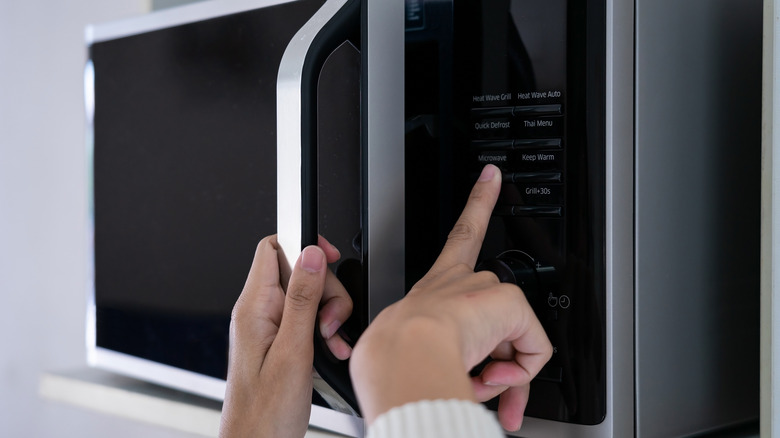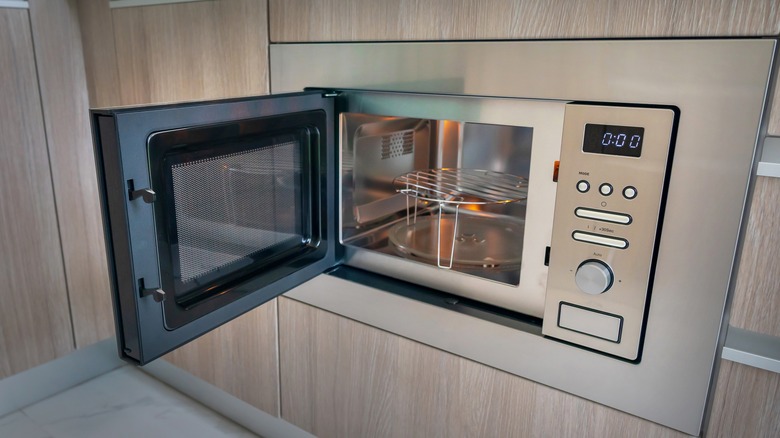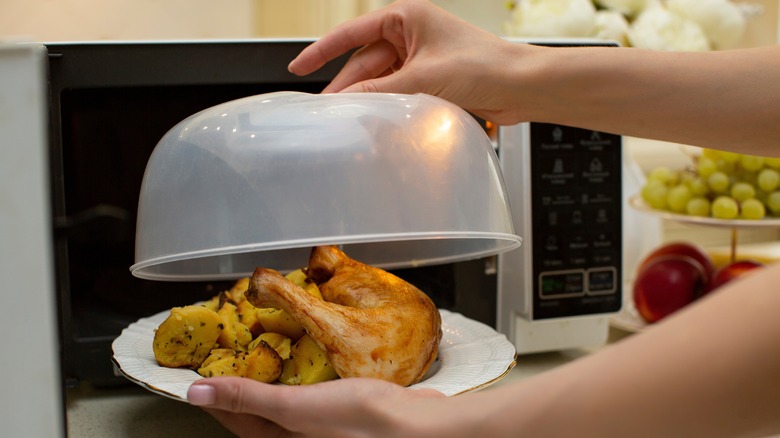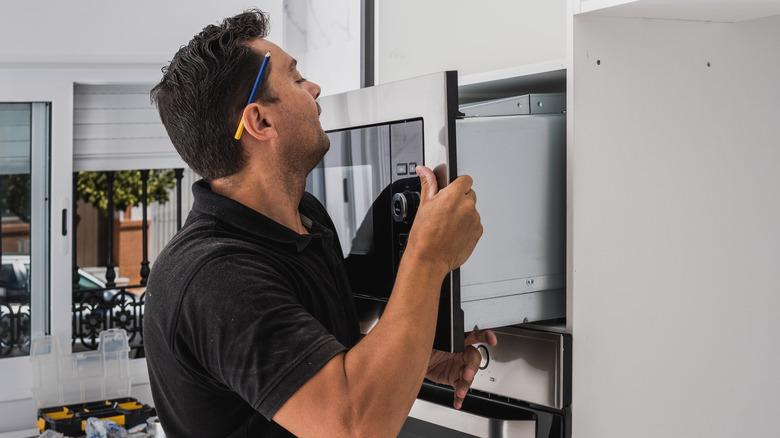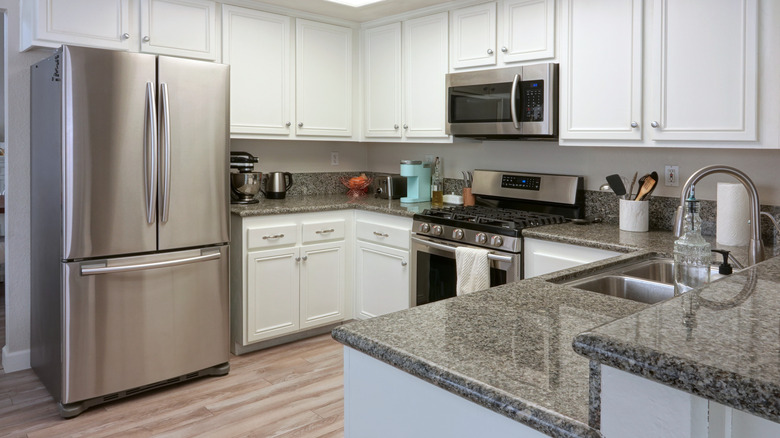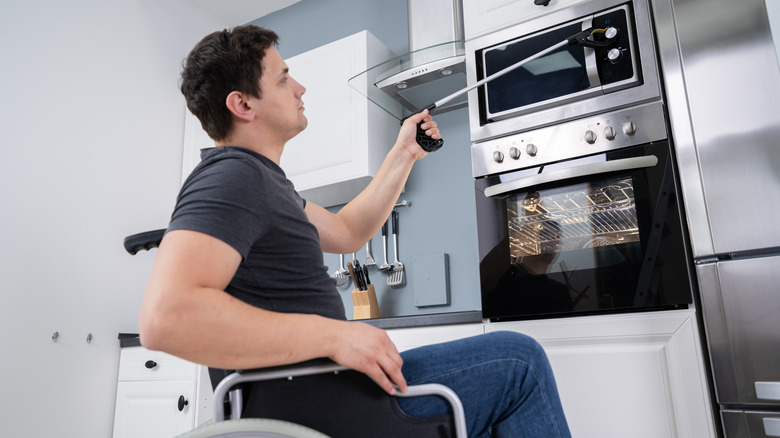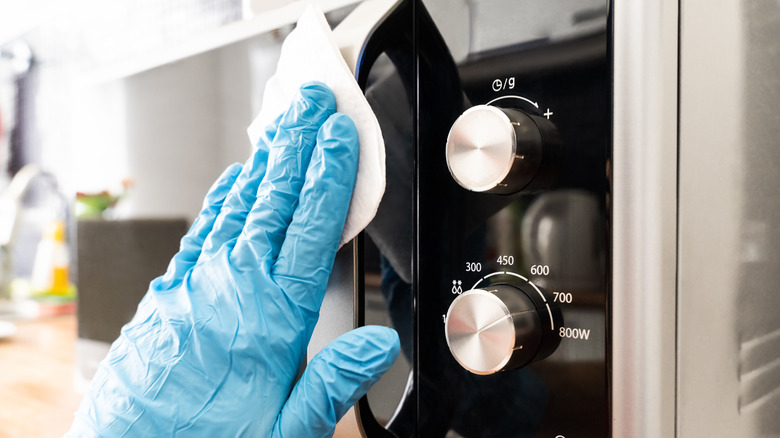Microwaves: What To Know Before You Buy
From reheating leftovers, popping popcorn, or even cooking whole meals, microwaves are a true workhorse in the kitchen. Whether you're looking for a new microwave to replace an older model that finally quit working, are renovating your kitchen, or need a second one for a game room in your home, there are a lot of factors and variables to consider before shopping.
According to the Chicago Tribune, Raytheon released the first microwave designed for individual use in 1947. Called the Radarange, this new invention — which was nearly 6 feet tall and weighed 750 pounds — cost approximately $58,000 in today's dollars ($5,000 at the time). While microwaves aren't as much of an investment as they used to be, you still want to do your research before making a purchase. Finding a microwave that satisfies all your needs and preferences, fits well in your kitchen, and offers reliable heating and cooking functions will help ensure that the model you select performs as desired. Read on to learn about the different factors you'll want to consider before buying a new microwave.
There are various types of microwave ovens
As you're shopping for a new microwave, you'll quickly notice that there are different types to consider. Consumer Reports identifies countertop, over-the-range, and built-in microwaves as the three main categories. However, as Whirlpool illustrates, there are a few other terms that are sometimes used to describe microwaves.
Countertop microwaves are a popular model found in many homes. They can be placed on any flat surface in the kitchen or another desired room. A second popular type of microwave is an over-the-range mode. As the name implies, these microwaves are installed above the range between the cabinets in the kitchen. They also function as a hood for the stove with ventilation settings. Built-in microwaves are installed into cabinets that are already within the kitchen. These models offer a more upscale feel with their sleeker designs.
You may also see a microwave described as "low-profile." This type of over-the-range microwave offers a more compact design to minimize installation space. Yet another option to consider is an under-counter microwave. Much like a drawer, these models slide out beneath the counter to allow users to place food from the top of the unit. Convection microwaves are another option some consumers prefer. They combine the features of a standard microwave with those of a convection oven.
While not as popular as other types, wall and oven microwave combinations are also available. This built-in combo features a microwave oven above a wall oven, placing both appliances in a convenient spot for cooking. Finally, as with many other appliances these days, there are also some smart microwaves on the market. These microwaves connect to cell phones and other home devices using Wi-Fi. This provides users with greater control over the foods they are cooking.
Microwaves come in a variety of sizes
When shopping for a new microwave, consider its external dimensions and internal capacity. Begin by measuring the available space in your kitchen where you would like to put the microwave — whether on the counter or above the range. Choosing a microwave that will fit in the available space is essential, as you don't want to have to deal with a return or come up with an alternative layout for your space.
Beyond looking at the overall dimensions of each model, it is also important to consider capacity. The internal capacity of a microwave is measured in cubic feet. Capacity can vary greatly for different models, with some smaller models only having a capacity of around 0.5 cubic feet to larger models offering over 2.0 cubic feet. And, as Whirlpool points out, the capacity range varies based on model type. For example, the smallest countertop microwaves have about 0.5 cubic feet capacity. In comparison, the smallest over-the-range and built-in microwaves are a little larger (starting around 0.8 cubic feet and 1.0 cubic feet, respectively).
Obviously, microwaves with larger dimensions can hold more food, which can speed up the cooking or reheating process. Another factor to consider when comparing the sizes of different models is whether your preferred microwave-safe plates and cookware will fit and have sufficient space to rotate.
Microwaves with a higher wattage will cook foods faster
Microwave wattage typically ranges between 600 to 1,200 watts, though a few models offer 1,500 watts or more. The higher the wattage, the more powerful the model and the faster it will be able to heat and cook foods. However, it isn't always as simple as choosing the highest wattage you can find. Different wattages are better suited to different cooking and reheating needs, as Appliance Analysts explain. Microwaves with 600 to 800 watts are the least powerful (and typically the least expensive) models. They will require longer to cook or reheat most foods and are best suited to less intense tasks, such as heating smaller portions or cooking instant meals.
800 to 1,000-watt microwaves are powerful enough to cook food and pop popcorn quickly, boil water, and ensure raw meat is cooked safely. This is typically the ideal wattage range for most residential customers: powerful, but not so much that it will burn foods. Microwaves with wattage in the 1,000 to 1,200 range tend to be used in restaurants and function more closely to ovens than lower-wattage models. They may be too powerful for most residential needs.
It is important to note, as Kolb Electric explains, that some older homes may not be able to supply the electricity necessary to operate these models. Regardless of the age of your home, it is also important — and legally required — to have a dedicated circuit for your microwave to reduce the risk of power surges or damage to the unit.
Settings and features will vary from one microwave to the next
Different microwave models may offer varying preset options, including defrost, popcorn, reheat, and more. According to Whirlpool and KitchenAid, some popular microwave setting options include defrost, add 30 seconds, soften/melt, crisp, steam, frozen entrée, popcorn, pizza reheat, soup, potato, dinner plate, and frozen vegetables.
Each consumer has unique needs and preferences. While some individuals don't care about or utilize the presets on their microwave, others find them helpful. If you are someone who likes the ease of pressing a single button rather than manually entering a cook time, you may want to look more closely at the included settings with the various models you are considering.
Also, always check the manufacturer's recommendations for each setting. For example, Whirlpool's direction for its "Soup" setting states to put between 1 to 4 cups of soup in a microwave-safe bowl, hit the dedicated setting, and then let it rest for two minutes after heating. Using one of the presets without following the directions could result in food that is hotter or colder than desired.
To maximize your purchase, consider a microwave that doubles as a convection oven
Convection microwaves offer two or more cooking modes. In addition to the standard microwave settings for cooking or warming food, these models also provide a convection mode. As Maytag explains, the convection setting on a microwave uses a fan to distribute the heat released to cook food, which is the same way convection ovens work. This means that in addition to the standard microwave uses, a convection microwave will also allow you to roast, bake, and broil foods.
Freedom Appliance highlights several benefits of convection microwaves. Beyond their increased functionality compared to standard models, convection microwaves are also ideal for smaller kitchens, RVs, or other areas that are tight on space. Rather than needing both an oven and a microwave, consumers can purchase just the one appliance that will allow for versatile cooking needs. This dual-functionality also means that convection microwaves can save consumers money by eliminating the need to buy two devices.
There are a few downsides to convection microwaves that you'll want to weigh before making a purchase. First, while they can save money when purchased to replace both an oven and microwave, they are more expensive than most standard microwaves. So, if you already have a range, you may decide that the additional cost is not worth it. Convection microwaves also have a smaller capacity than full-size ovens, making it challenging to cook roasts or other larger dishes.
Sensor cooking features can save time and effort
Some microwaves offer a sensor-cooking feature to automatically adjust the power level and cooking time for reheating or cooking foods. The sensors measure food's temperature and moisture levels to identify when it is cooked or heated through. Once the moisture and temperature levels reach the predetermined level (which varies based on the type of food you are cooking and the setting you select), the microwave will automatically stop cooking.
Appliances Connection highlights several benefits of using the sensor cooking features offered by some microwaves. With traditional settings, the microwave emits radiation for as long as it is running (the amount of time you set it for). If you inadvertently set the time for longer than is needed, your food may come out dry or burned. Because sensor cooking watches the temperature and moisture levels, the microwave automatically stops cooking when the items are done, reducing the risk of your meal becoming subpar.
Another benefit of sensor cooking is that it requires fewer adjustments and monitoring on your part. Rather than guessing how long foods will need to heat or cook, you can simply select the setting that matches what you're heating. You also won't need to babysit the microwave and open the door periodically to check the progress of the items you're cooking. The temperature and moisture sensors will take care of that task for you. Simply place your item in the microwave, choose the appropriate setting, and move on to another task on your to-do list.
Consider how much money you want to invest in a new microwave
If you've looked around at microwaves already, you may have noticed a substantial price difference between some models. Angi reports that microwaves can cost as little as $50 up to as much as $2,000. Generally speaking, countertop microwaves are the least expensive, while built-in microwaves cost more (up to $2,000). However, wattage and the different features and settings offered by each model will also impact its total cost.
Before purchasing a new microwave, assess your cooking needs and decide how much you really need to invest in this purchase. Review the information shared above related to wattage and settings. For example, the ideal microwave for someone who primarily uses it to reheat frozen dinners will look quite different from those looking to replace the oven in their tighter kitchen. A cheaper and smaller microwave with a lower wattage would likely be sufficient for the first person in this example, while the second person may need to spend more on a higher-end convection microwave.
Unless you're looking for a built-in microwave to give your kitchen a truly professional look, you should be able to find reasonably-priced options to match your budget and cooking needs and preferences.
Some microwaves require installation, while others can simply be plugged in
When considering the costs and logistics of purchasing a new microwave, you'll also want to consider whether installation is necessary. Countertop microwaves do not require any special installation. They can simply be unpacked from the box, placed in the desired location, and plugged into the wall. (However, remember that a dedicated circuit is required for all models).
On the other hand, over-the-range and built-in microwaves require professional installation. As Angi points out, the installation cost will vary depending on the electrical requirement and whether any modifications need to be made to your cabinetry. The installation cost for an over-the-range microwave is generally between $100 and $200. Built-in microwaves are typically more expensive to install, costing up to $335. However, if your cabinets need to be customized to fit the microwave, prepare to spend more — up to $2,000.
Depending on the current layout of your kitchen, you may also need to budget for additional costs. Installing a new electrical outlet for the microwave will cost between $135 and $300. If you're getting an over-the-range microwave for the first time and need to set up the hood venting system, you could be out an additional $400 to $1,500.
Some models will include a manufacturer's warranty to protect your purchase
Many microwaves come with a manufacturer's warranty, typically for one year. American Home Shield explains that manufacturers' warranties cover parts and labor for the specified period following the purchase or installation date. If something breaks or malfunctions on your microwave that wasn't caused by improper use, the manufacturer will likely cover the necessary repairs.
When you purchase a new microwave, you may also have the opportunity to buy an extended warranty. Most retailers offer these extensions, especially for over-the-range or built-in models, for a few years beyond what the manufacturer's warranty covers. With an extended warranty, you can contact the warranty provider to arrange for repairs, which should be covered.
However, according to Consumer Reports, purchasing an extended warranty is rarely worth the cost. Appliances like microwaves are reliable and statistically unlikely to experience major flaws. Moreover, if you encounter an issue with your microwave, it is not likely that the repair cost will be more than what you paid for the warranty.
The average lifespan of a microwave is nine years
According to Consumer Reports, the average lifespan of a microwave is nine years. However, some models will last longer, while others may stop working well before nine years have passed. Keep this in mind while shopping and planning a budget to assess whether a specific model is within your price range. Knowing the average lifespan can also help you determine whether it is worth putting money into repairing an old microwave instead of purchasing a new one.
Another key consideration when deciding whether to purchase a new microwave is energy efficiency. In 2013, the United States Department of Energy released new energy efficiency standards for microwaves. These standards are designed to help households reduce their energy costs and minimize carbon pollution. These standards are projected to save nearly $3 billion in energy costs by 2030. If you have an older microwave, updating to a new model may help reduce your energy bills.
You can extend the lifespan of your microwave with proper cleaning and care
While the average lifespan of a microwave is just nine years, it is possible for these appliances to last years longer than this. According to information shared by Consumer Reports, proper care and cleaning can help extend a microwave's lifespan. One way to keep your appliance working as long as possible is to clean up spills quickly. This can help prevent the formation of hot spots that can damage the inside of the unit. Use a warm, damp cloth to wipe down the inside of the microwave to remove stains.
If you have an over-the-range microwave, running the exhaust fan while cooking on the stovetop is also important. Doing so can help prevent moisture from collecting on the appliance's electrical components, which can cause it to stop working sooner. Another important tip is to avoid running your microwave if it is empty. Running it with nothing in it can cause it to overheat or leave burn marks.
If your microwave offers preset features, using them can also help extend its lifespan. These settings can prevent foods from getting overcooked or splattering sauces/juices inside the unit. Using the presets can also prevent an accidental input mistake — such as entering 30:00 instead of 3:00 — which can overheat the unit or leave burn marks.

